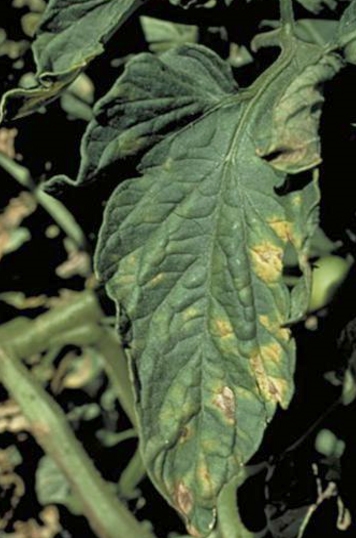
Powdery Mildew
Laveillula Taurica
Pathogen:
Fungus
Type:
Risk:
INTERMEDIATE




DESCRIPTION
Pathogen description
Laveillula taurica is a fungus belonging to the group of ascomycetes and is known to cause powdery mildew in various plants, including tomatoes. This pathogen is endoparasitic, which means that it lives and develops within the plant tissue of the host. Laveillula taurica produces conidia, which are asexual spores, on the surface of infected leaves. These spores are dispersed primarily by wind and, upon contact with a susceptible plant, germinate and penetrate leaf tissue. The fungus develops mycelia inside the plant, extracting nutrients and causing the appearance of reproductive structures on the leaf surface. Under favorable conditions, the cycle of infection and sporulation can be repeated rapidly, facilitating the spread of the pathogen in the crop.
Disease description
Powdery mildew caused by Laveillula taurica in tomato initially manifests itself with chlorotic Taches on the leaves, which progress to the appearance of a characteristic whitish powder on the lower surface of the leaves. This mycelium and sporulation of the fungus interfere with photosynthesis and normal growth of the plant, weakening it significantly.
- Chlorotic Taches on the leaves
- Appearance of a white powder on the lower surface of the leaves
- Curling and yellowing of leaves
- Premature defoliation
- Reduction in plant growth
- General loss of vigor
- Decrease in production and quality of fruits

TEMPERATURE AND HUMIDITY
20-30°C
60-80%

VOIES DE TRANSMISSION
Wind, contaminated tools, direct contact with infected plants, infected crop remains, contaminated irrigation water

Chemical treatments
CONTROL
• AZOXISTROBIN 20% + DIFENOCONAZOLE 12.5% [SC] P/V
• AZOXISTROBIN 25% [SC] P/V
• SULFUR 80% [DP] P/P
• SULFUR 80% [SC] P/V
• SULFUR 80% [WG] P/P
• SULFUR 80% [WP] P/P
• SULFUR 82.5% [SC] P/V
• SULFUR 98.5% [DP] P/P
• SULFUR 99% [DP] P/P
• BUPIRIMATE 25% [EC] P/V
• CIFLUFENAMID 10% [SC] P/V
• COS-OGA 1.25% [SL] P/V
• DIFENOCONAZOLE 12.5% + CYFLUFENAMIDE 1.5% [DC] P/V
• DIFENOCONAZOLE 25% [EC] P/V
• EUGENOL 3.3% + GERANIOL 6.6% + THYMOL 6.6% [CS] P/V
• FLUOPYRAM 40% [SC] P/V
• FLUXAPYROXAD 7.5% + DIFENOCONAZOLE 5% [SC] P/V
• POTASSIUM HYDROGEN CARBONATE 0.425% [AL] P/V
• POTASSIUM HYDROGEN CARBONATE 85% [SP] P/P
• KRESOXIM-METHYL 50% [WG] P/P
• LAMINARIN 4.5% [SL] P/S
• Penconazole 10% [EC] P/V
• PENCONAZOLE 20% [EW] P/V
• PIRACLOSTROBIN 6.7% + BOSCALIDE 26.7% (I) [WG] P/P
• TEBUCONAZOLE 25% [WG] P/P
• TETRACONAZOLE 12.5% [ME] P/V
• TETRACONAZOLE 4% [ME] P/V
• TRIFLOXISTROBIN 50% [WG] P/P
Treatments authorized in organic farming
• SULFUR 80% [DP] P/P
• SULFUR 80% [SC] P/V
• SULFUR 80% [WG] P/P
• SULFUR 80% [WP] P/P
• SULFUR 82.5% [SC] P/V
• SULFUR 98.5% [DP] P/P
• SULFUR 99% [DP] P/P
• COS-OGA 1.25% [SL] P/V
• EUGENOL 3.3% + GERANIOL 6.6% + THYMOL 6.6% [CS] P/V
• POTASSIUM HYDROGEN CARBONATE 0.425% [AL] P/V
• POTASSIUM HYDROGEN CARBONATE 85% [SP] P/P
• LAMINARIN 4.5% [SL] P/S
Biological control
• AMPELOMICES QUISQUALIS 58% [WG] P/P
• BACILLUS AMYLOLIQUEFACIENS (strain FZB24) 13% [WP] P/P
• Bacillus pumilus strain QST 2808 (1x10E9 CFU/g) 14.35g/L [SC] P/V
Preventive treatments
• AMPELOMICES QUISQUALIS 58% [WG] P/P
• AZOXISTROBIN 20% + DIFENOCONAZOLE 12.5% [SC] P/V
• AZOXISTROBIN 25% [SC] P/V
• SULFUR 80% [DP] P/P
• SULFUR 80% [SC] P/V
• SULFUR 80% [WG] P/P
• SULFUR 80% [WP] P/P
• SULFUR 82.5% [SC] P/V
• SULFUR 98.5% [DP] P/P
• SULFUR 99% [DP] P/P
• BACILLUS AMYLOLIQUEFACIENS (strain FZB24) 13% [WP] P/P
• Bacillus pumilus strain QST 2808 (1x10E9 CFU/g) 14.35g/L [SC] P/V
• BUPIRIMATE 25% [EC] P/V
• CIFLUFENAMID 10% [SC] P/V
• DIFENOCONAZOLE 12.5% + CYFLUFENAMIDE 1.5% [DC] P/V
• DIFENOCONAZOLE 25% [EC] P/V
• EUGENOL 3.3% + GERANIOL 6.6% + THYMOL 6.6% [CS] P/V
• FLUXAPYROXAD 7.5% + DIFENOCONAZOLE 5% [SC] P/V
• POTASSIUM HYDROGEN CARBONATE 0.425% [AL] P/V
• POTASSIUM HYDROGEN CARBONATE 85% [SP] P/P
• KRESOXIM-METHYL 50% [WG] P/P
• LAMINARIN 4.5% [SL] P/S
• Penconazole 10% [EC] P/V
• PENCONAZOLE 20% [EW] P/V
• PIRACLOSTROBIN 6.7% + BOSCALIDE 26.7% (I) [WG] P/P
• TEBUCONAZOLE 25% [WG] P/P
• TETRACONAZOLE 12.5% [ME] P/V
• TETRACONAZOLE 4% [ME] P/V
• TRIFLOXISTROBIN 50% [WG] P/P
- Select tomato varieties resistant or tolerant to powdery mildew.
- Maintain good ventilation and adequate spacing between plants to reduce relative humidity.
- Apply treatments with broad-spectrum preventive fungicides specific for powdery mildew.
- Carry out regular pruning to eliminate infected leaves and improve air circulation.
- Implement crop rotations to avoid the accumulation of the pathogen in the soil.
- Use micronized sulfur as a preventive treatment in the early phases of the crop.
- Regularly monitor the crop to detect the first symptoms of the disease.
- Avoid sprinkler irrigation that can increase humidity in the foliage.
Recommendations
*The recommended treatments are recommendations based on the authorities' databases and do not replace in any way the guidelines established by the legislation of each country.





